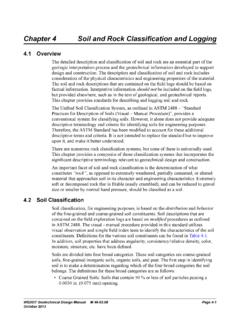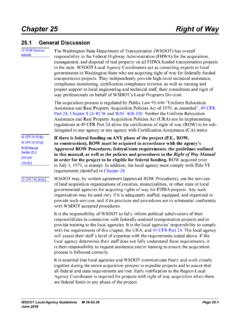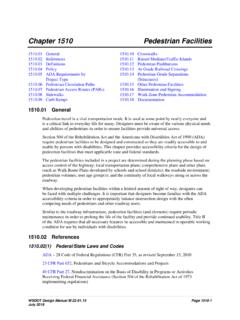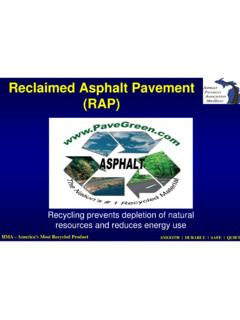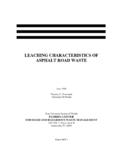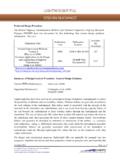Transcription of Use of Steel Slag Aggregate in Pavements Report - …
1 1 WSDOT Strategies Regarding Use of Steel Slag Aggregate in Pavements A Report to the State Legislature In Response to 2 ESHB 1299 Prepared by: washington State DOT Construction Division Pavements Office November 2015 2 Table of Contents Executive summary .. 2 Introduction .. 5 Report Organization .. 5 Steel Slag Aggregate 5 Steel Slag Aggregate Research .. 8 Steel Slag Aggregate For Hot-Mix Asphalt, Chip Seals and Stone Mastic Asphalt .. 8 SSA for Portland Cement Concrete Pavements .
2 10 SSA for Bases and 11 Steel Slag Aggregate Advantages and Disadvantages .. 12 State Use of Steel Slag Aggregate .. 13 Illinois .. 13 13 14 Minnesota .. 14 Missouri .. 14 14 Pennsylvania .. 15 South Carolina .. 15 West Virginia .. 16 summary of Acceptance Criteria .. 16 summary of State Uses .. 16 Other states .. 17 Recommendations .. 17 References .. 18 3 Executive summary 2 ESHB 1299, Section 307 (5) in the 2015 Legislative Session required the washington State department of transportation to study the use of electric arc furnace slag for use as aggregates in Pavements as noted below.
3 The department shall examine the use of electric arc furnace slag for use as an Aggregate for new roads and paving projects in high traffic areas and Report back to the legislature by December 1, 2015, on its current use in other areas of the country and any characteristics that can provide greater wear resistance and skid resistance in new pavement construction. As a result, a literature review was conducted to examine the properties of Steel slag Aggregate (SSA) and its use as an Aggregate for Pavements .
4 The discussion below condenses the literature review and provides WSDOT s action plan to further evaluate electric arc furnace slag. Steel slag Aggregate (SSA) is a byproduct of the production of Steel in an electric arc furnace. The high iron oxide content of the Aggregate results in an Aggregate that is very hard and very dense (SSA is 20-30% heavier than naturally occurring aggregates such as basalt and granite). It also contains a high content of calcium and magnesium oxides, which make it expand when it comes into contact with moisture.
5 It is very angular and porous. The primary use of SSA is as a substitute for natural aggregates in the production of hot-mix asphalt (HMA). It is used less often in supporting courses (bases and subbases) beneath HMA or bituminous surface treatment (BST) wearing courses. It is not used in cement concrete Pavements or other concrete applications due to the expansive nature of the aggregates since expansion causes the concrete to crack. All users specify that the Aggregate be cured in a water saturated condition for a period of 3-6 months prior to use in non-HMA applications.
6 Many states require an expansion test in addition to the water curing. The higher weight and high porosity of the Aggregate can result in additional cost when used in HMA. The higher weight increases the cost of hauling the Aggregate from the source to the job site and the high porosity of the Aggregate results in a demand for more asphalt binder than mixes using natural aggregates. The higher weight of the SSA mix means that a given weight of mix will not cover the same volume of pavement as a conventional mix with natural Aggregate , therefore more tons of mix are required to cover the same length, width and depth of pavement than conventional HMA.
7 This, along with the need for more asphalt binder, raises costs. Most of the states that use SSA are located in the Steel producing states between Minnesota and Iowa on the west and Pennsylvania, Virginia and West Virginia on the east. The requirements for acceptance of the aggregates varies between the states , with some requiring moist curing or an expansion test and others allowing its use in hot-mix asphalt without curing or expansion testing. Most states use the SSA in the top layer of the pavement to increase the frictional properties of the pavement ; however, two states do not allow SSA in the top layer, so use is mixed.
8 4 The use of SSA in bases and subbases was not specifically called out in the language of the transportation bill; however, the literature indicated that the high pH of some Steel slag aggregates may be a problem with respect to corrosion of culverts and aquatic life in streams and rivers adjacent to roadways. Without adequate testing the use of SSA is not recommended for use as Aggregate base for WSDOT roadways. Information on the cost of using SSA is difficult to quantify. The states that use SSA as a friction enhancer indicate that the added cost is equivalent to the cost of importing better aggregates from adjacent states .
9 The washington state contractor that uses SSA in the Seattle area on private projects indicates a cost savings over using natural aggregates from company owned sources. Due to limitations on the availability of SSA, limited to Nucor facility in Seattle, it is not economical to use SSA to replace natural Aggregate where long haul distances to an asphalt producer are involved. The use of SSA in washington seems to be a viable option with the primary advantage being the conservation of natural aggregates.
10 Use should be limited to hot-mix asphalt with laboratory testing required to assess the quality of the Aggregate and its strength under repeated loads and moisture. All projects using Steel slag Aggregate should be classified as experimental. WSDOT is proposing a pilot project in 2016 to evaluate the use of SSA on an asphalt paving project. The proposed project will be constructed in the Northwest Region within a reasonable distance to Nucor facility to make the project economical. The project will include a one mile long test section of Steel slag Aggregate with the remainder of the project built using conventional HMA with natural aggregates.






